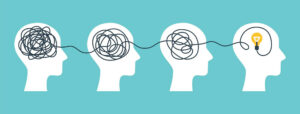Individuals living with bipolar disorder often find themselves grappling with challenging emotions, distorted thought patterns, and disruptions in daily functioning. Amidst various therapeutic approaches, Eye Movement Desensitization and Reprocessing (EMDR) therapy has emerged as a promising intervention for addressing the intricate symptoms associated with bipolar disorder. In this blog, we will delve into the intricacies of EMDR therapy for bipolar, exploring its mechanisms, benefits, and applicability for individuals.
Contents
Can EMDR Help With Bipolar Disorder?
 Eye Movement Desensitization and Reprocessing (EMDR) therapy is primarily recognized for its effectiveness in treating trauma and post-traumatic stress disorder (PTSD). While it is not a first-line treatment for bipolar disorder, there is some evidence to suggest that EMDR could be beneficial for individuals with this condition. Particularly when their symptoms are intertwined with traumatic experiences. The connection between trauma and the severity of bipolar disorder symptoms highlights the potential for EMDR to mitigate mood instability by addressing underlying traumatic memories and associated negative thought patterns.
Eye Movement Desensitization and Reprocessing (EMDR) therapy is primarily recognized for its effectiveness in treating trauma and post-traumatic stress disorder (PTSD). While it is not a first-line treatment for bipolar disorder, there is some evidence to suggest that EMDR could be beneficial for individuals with this condition. Particularly when their symptoms are intertwined with traumatic experiences. The connection between trauma and the severity of bipolar disorder symptoms highlights the potential for EMDR to mitigate mood instability by addressing underlying traumatic memories and associated negative thought patterns.
EMDR therapy for bipolar aims to help patients reprocess traumatic memories. That eventually results in a decrease in the emotional charge of those memories and an improvement in associated symptoms. However, it is crucial to approach the use of EMDR in treating bipolar disorder with caution and under the guidance of a qualified mental health professional. The integration of EMDR therapy for bipolar disorder should be personalized and carefully monitored.
What Techniques Are Used In EMDR Therapy For Bipolar?
EMDR therapy for bipolar disorder utilizes a structured eight-phase approach. This is similar to its application in treating trauma and PTSD. However, the therapist might adapt certain aspects to accommodate the unique challenges and needs. Here are the key techniques and phases used in EMDR therapy for bipolar:
History Taking and Treatment Planning
The initial phase of EMDR therapy involves an in-depth exploration of the patient’s history, focusing on identifying traumatic events and experiences that may be contributing to the symptoms of bipolar disorder. The therapist collaborates with the patient to pinpoint specific memories that will be targeted for reprocessing. In individuals with bipolar disorder, this phase is crucial, as it sets the foundation for the entire therapeutic process.
Preparation
The therapist dedicates time to building trust and rapport with the patient, ensuring they feel safe and supported. They provide a detailed explanation of the EMDR process, demystifying the therapy and setting clear expectations. An essential component of this phase is the development of grounding and self-soothing techniques. These skills are invaluable for individuals with bipolar disorder, as they help to navigate emotional turbulence and maintain a sense of balance.
Assessment
In this phase, the therapist and patient work together to identify the negative belief associated with the target memory. They also develop a positive cognition that the patient would like to hold instead. The therapist helps the patient gauge the level of emotional distress and the physical sensations connected to the memory, establishing a baseline for the work ahead. This phase is critical for setting specific, measurable goals for the therapy.
Desensitization
 The heart of the EMDR process lies in desensitization, where the therapist guides the patient through bilateral stimulation, typically in the form of guided eye movements. This process aims to reduce the emotional intensity of the target memory. For individuals with bipolar disorder, careful monitoring is required to ensure that the therapy does not inadvertently trigger mania or rapid cycling.
The heart of the EMDR process lies in desensitization, where the therapist guides the patient through bilateral stimulation, typically in the form of guided eye movements. This process aims to reduce the emotional intensity of the target memory. For individuals with bipolar disorder, careful monitoring is required to ensure that the therapy does not inadvertently trigger mania or rapid cycling.
Installation
With the emotional charge of the memory reduced, the focus shifts to reinforcing the positive cognition identified in the assessment phase. The goal is to integrate this positive belief more fully, promoting a healthier perspective and response to the memory and associated events.
Body Scan
The patient is guided through a body scan to identify any residual tension or discomfort linked to the target memory. If any physical sensations are found, additional bilateral stimulation may be used to address and alleviate them, aiming for complete resolution.
Closure
This phase is crucial, especially for individuals with bipolar disorder. The therapist ensures that the patient leaves each session feeling stable and grounded, regardless of the progress made in reprocessing the target memory. The focus is on maintaining emotional balance and ensuring the patient’s well-being.
Reevaluation
In the final phase, the therapist assesses the impact of the therapy on the target memory and any related bipolar symptoms. This evaluation helps in determining the efficacy of the treatment. Thus further making necessary adjustments to the treatment plan. The therapist and patient reflect on the progress made and plan the next steps in the therapeutic journey. Ultimately, ensuring ongoing support and stability.
Incorporating EMDR therapy for bipolar requires a nuanced approach. This is about taking into consideration the unique challenges and sensitivities of the condition. Therapists must be well-versed in both EMDR and bipolar disorder to provide effective and safe treatment.
What Are The Benefits Of EMDR Therapy For Bipolar?
EMDR (Eye Movement Desensitization and Reprocessing) therapy has shown promise in treating various mental health conditions. And it might offer specific benefits for individuals with bipolar disorder. Here are some potential benefits:
1. Reduction in the Intensity of Traumatic Memories
EMDR aims to help individuals reprocess traumatic memories, reducing their emotional charge. For those with bipolar disorder, this can be particularly beneficial as traumatic experiences might contribute to the severity and frequency of mood episodes.
2. Improvement in Emotional Regulation
By addressing the root causes of emotional distress, EMDR can aid in enhancing emotional regulation. This improvement is crucial for individuals with bipolar disorder. As it can lead to more stable moods and reduce the risk of rapid cycling between mood states.
3. Decrease in Symptoms of Anxiety and Depression
EMDR therapy has been found to be effective in reducing symptoms of anxiety and depression, common comorbid conditions with bipolar disorder. Alleviating these symptoms can contribute to an overall enhancement in quality of life.
4. Enhanced Self-Esteem and Self-Efficacy
The therapy promotes a shift from negative self-beliefs to more positive and empowering beliefs. This can bolster self-esteem and the belief in one’s ability to cope, crucial for those navigating the challenges of bipolar disorder.
5. Reduction in Avoidance Behaviors
Individuals with bipolar disorder, particularly those with co-occurring trauma, might engage in avoidance behaviors as a coping mechanism. EMDR works to address the root of these behaviors, encouraging healthier coping strategies.
6. Promoting Overall Mental Well-Being
By addressing underlying issues and fostering resilience, EMDR contributes to an overall sense of mental well-being. This is integral for long-term stability in bipolar disorder.
7. Encouraging a Proactive Approach to Mental Health
Engaging in EMDR therapy requires active participation and reflection. And, promoting a proactive and engaged approach to managing one’s mental health.
It’s important to note that while EMDR can offer these benefits, it is not a standalone treatment for bipolar disorder. Hence, it is most effective when integrated into a comprehensive treatment plan.
When Should You Avoid EMDR?
 EMDR is a powerful therapeutic technique. However, it is not suitable for everyone or for all types of psychological issues. There are certain situations and conditions where EMDR should be avoided or used with extreme caution:
EMDR is a powerful therapeutic technique. However, it is not suitable for everyone or for all types of psychological issues. There are certain situations and conditions where EMDR should be avoided or used with extreme caution:
- Severe Mental Health Disorders: Individuals with severe mental health disorders. Such as psychosis, bipolar disorder with severe manic symptoms, or severe dissociative disorders may not be suitable candidates for EMDR.
- Unstable Living Situations: For EMDR to be safe and effective, individuals need to have a stable and supportive living environment. If someone is currently experiencing severe life stressors or lacks a support network, EMDR may need to be postponed until stability is achieved.
- Substance Abuse Issues: Active substance abuse or dependence can complicate the EMDR process. Individuals should be sober and in recovery before starting EMDR therapy.
- Severe Suicidal Ideation: If someone is currently experiencing severe suicidal thoughts or has a plan for suicide, they require immediate crisis intervention. EMDR should only be considered once the individual is stabilized and the immediate risk is addressed.
- Certain Medical Conditions: Some medical conditions, particularly neurological conditions, might be contraindications for EMDR. It is essential to thoroughly discuss one’s medical history with the therapist before starting EMDR.
- Unresolved Grief or Loss: For those who are experiencing acute grief or loss. Then, it might be more beneficial to engage in supportive counseling or grief therapy before considering EMDR.
- Pregnancy: Pregnant individuals should consult with their healthcare provider before starting EMDR. The therapy can induce intense emotional responses which could potentially have implications for pregnancy.
- Lack of Motivation or Commitment: EMDR requires active participation and a commitment to the process. If an individual is not motivated or ready to fully engage in therapy, EMDR might not be the right choice at that time.
Before starting EMDR, it is crucial to have a comprehensive assessment conducted by a qualified and experienced therapist. This assessment will help to ensure that EMDR is a safe and appropriate therapeutic option.
Conclusion
In conclusion, while EMDR therapy is primarily recognized for its effectiveness in treating trauma and PTSD, its potential benefits for individuals with bipolar disorder. Especially those with co-occurring traumatic experiences, cannot be overlooked. The structured, eight-phase approach of EMDR can provide a framework for addressing and reprocessing traumatic memories. This potentially leads to a reduction in the intensity of these memories and an improvement in mood stability.
With the guidance of a qualified mental health professional, EMDR can serve as a valuable adjunct to traditional treatments for bipolar disorder. And, contributing to a holistic approach that addresses both the neurological and psychological aspects of the disorder. If you are looking for affordable Bipolar Disorder Counseling in India TherapyMantra can help: Book a trial Online therapy session


